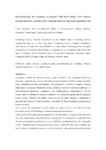Mostrar o rexistro simple do ítem
Individualizing the treatment of patients with heart failure with reduced ejection fraction: a journey from hospitalization to long-term outpatient care
| dc.contributor.author | Escobar, Carlos | |
| dc.contributor.author | Bonilla-Palomas, Juan Luis | |
| dc.contributor.author | Crespo-Leiro, María Generosa | |
| dc.contributor.author | Esteban-Fernández, Alberto | |
| dc.contributor.author | Farré, Nuria | |
| dc.contributor.author | García, Ana | |
| dc.contributor.author | Núñez, Julio | |
| dc.date.accessioned | 2022-09-30T10:31:34Z | |
| dc.date.issued | 2022-08-31 | |
| dc.identifier.citation | Escobar C, Luis-Bonilla J, Crespo-Leiro MG, Esteban-Fernández A, Farré N, Garcia A, Nuñez J. Individualizing the treatment of patients with heart failure with reduced ejection fraction: a journey from hospitalization to long-term outpatient care. Expert Opin Pharmacother. 2022 Aug 31:1-11. Epub ahead of print. | es_ES |
| dc.identifier.issn | 1465-6566 | |
| dc.identifier.uri | http://hdl.handle.net/2183/31747 | |
| dc.description | Review | es_ES |
| dc.description.abstract | [Abstract] Introduction: Despite the relevant advances achieved thanks to the traditional step-by-step therapeutic approach, heart failure with reduced ejection fraction (HFrEF) remains associated with considerable morbidity and mortality. The pathogenesis of HFrEF is complex, with the implication of various neurohormonal systems, including activation of deleterious pathways (i.e. renin-angiotensin-aldosterone, sympathetic, and sodium-glucose cotransporter-2 [SGLT2] systems) and the inhibition of protective pathways (i.e. natriuretic peptides and the guanylate cyclase system). Therefore, the burden of HF can only be reduced through a comprehensive approach that involves all evidence-based use of available HF drugs targeting the neurohormonal systems involved. Areas covered: We performed a critical analysis of evidence from recent clinical trials and assessed the effects of HF therapies on hemodynamics and renal function. Expert opinion: HF therapy must be adapted to the clinical profile (i.e. congestion, blood pressure, heart rate, renal function, and electrolytes). Consequently, blood pressure is reduced by beta blockers, renin-angiotensin-aldosterone system inhibitors, sacubitril/valsartan, and, minimally, by SGLT2 inhibitors and vericiguat; heart rate decreases with beta blockers and ivabradine; and renal function is impaired and potassium are levels increased with renin-angiotensin-aldosterone system inhibitors and sacubitril/valsartan. Practical recommendations on how to individualize HF therapy according to patient profile are provided. | es_ES |
| dc.language.iso | eng | es_ES |
| dc.publisher | Taylor & Francis | es_ES |
| dc.relation.uri | https://doi.org/10.1080/14656566.2022.2116275 | es_ES |
| dc.subject | Beta blockers | es_ES |
| dc.subject | SGLT2 inhibitors | es_ES |
| dc.subject | Heart failure | es_ES |
| dc.subject | Ivabradine | es_ES |
| dc.subject | Renin angiotensin aldosterone system inhibitors | es_ES |
| dc.subject | Sacubitril/valsartan | es_ES |
| dc.subject | Vericiguat | es_ES |
| dc.title | Individualizing the treatment of patients with heart failure with reduced ejection fraction: a journey from hospitalization to long-term outpatient care | es_ES |
| dc.type | info:eu-repo/semantics/article | es_ES |
| dc.rights.access | info:eu-repo/semantics/embargoedAccess | es_ES |
| dc.date.embargoEndDate | 2023-08-31 | es_ES |
| dc.date.embargoLift | 2023-08-31 | |
| UDC.journalTitle | Expert Opinion on Pharmacotherapy | es_ES |
Ficheiros no ítem
Este ítem aparece na(s) seguinte(s) colección(s)
-
INIBIC-ICATC - Artigos [156]






